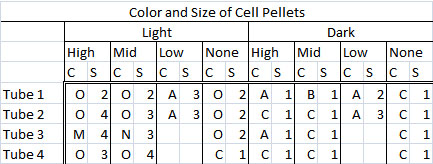|
Introduction
Bacteriorhodopsin is a membrane protein of halobacteria that acts as a proton pump, converting light energy into chemical energy that the cell can use. It is purplish in color, and when the cell is producing large quantities of this protein, it is clearly purple. The production of Bacteriorhodopsin is regulated by the Bat gene, whose expression is dependent upon the amount of oxygen and light that the cell receives. In this lab, we wanted to alter both the oxygen level and the amount of light that the cells received in order to observe possible differences in cell phenotype and cell growth.
Procedure
- Add 15 mL of Complete Media to each of the 50mL flasks.
- Add 300 μL of Halobacterium with an OD of about 1.2 to each flask.
- Add a stir stick to each flask.
- Cover the top of each flask with a piece of aluminum foil.
- Label the flasks as following:
High-1-Light |
High-1-Dark |
Mid-1-Light |
Mid-1-Dark |
Low-1-Light |
None-1-Light |
None-1-Dark |
High-2-Light |
High-2-Dark |
Mid-2-Light |
Mid-2-Dark |
Low-2-Light |
None-2-Light |
None-2-Dark |
High-3-Light |
High-3-Dark |
Mid-3-Light |
Mid-3-Dark |
Low-1-Dark |
None-3-Light |
None-3-Dark |
High-4-Light |
High-4-Dark |
Mid-4-Light |
Mid-4-Dark |
Low-2-Dark |
None-4-Light |
None-4-Dark |
Also label each flask with the date, “Halo NRC-1”, and your initials
- Place each tube from the columns above on their own hot plate except the ones labeled “none”.
- Cover each flask labeled “dark” completely with aluminum foil so that light cannot enter.
- Making sure to record the time you start spinning, turn on the plates with flasks labeled “high” to spin at level 5, the plates with the flasks labeled “mid” to spin at level 3 and the plate with flasks labeled “low” to spin at level 1.
- Measure the oxygen and temperature of each flask throughout the experiment (to last about 72 hours)
Results
Temperature and OD Plot (The flasks with no spinning shown in blue)


(S=Size of Pellet, was relative to the other pellets, on a scale of 1-4. C=Color of pellet, is based on scale below)

Conclusion
From this experiment, we could see the effects of temperature on growth of Halobacteria; as temperature increased, so did the OD600, our measure for growth. We also saw a clear indication that as time progresses, the amount of oxygen dissolved in the culture decreases. However, there was no real difference in the rate of decrease of dissolved oxygen between the amounts of light or the speed of spinning. In terms of the pellets, they tended to be more purplish-pink if they had been in the light and more orangey if they had been in the dark. This makes sense because Halobacteria produce Bacteriorhodopsin when they have both light and oxygen, which gives them that purplish color exhibited by the Halo that had been in the light. This experiment confirmed that the more light, heat, and oxygen the Halobacteria get, the more they will grow and the darker a purple they will be.
|



